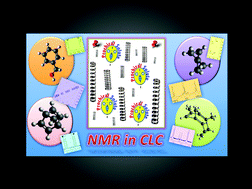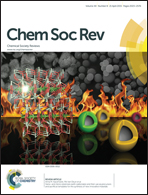Enantiotopic discrimination in the NMR spectrum of prochiral solutes in chiral liquid crystals
Abstract
The splitting of signals in the NMR spectra originating from enantiotopic sites in prochiral molecules when dissolved in chiral solvents is referred to as spectral enantiotopic discrimination. This phenomenon is particularly noticeable in chiral liquid crystals (CLCs) due to the combined effect of the anisotropic magnetic interactions and the ordering of the solute in the mesophase. The enantiorecognition mechanisms are different for rigid and flexible solutes. For the former, discrimination results from symmetry breaking and is restricted to solutes whose point groups belong to one of the following four (“allowed”) symmetries, Cs, C2v, D2d and S4. The nature of the symmetry breaking for each one of these groups is discussed and experimental examples, using mainly 2H 1D/2D-NMR in chiral polypeptide lyotropic mesophases, are presented and analyzed. When flexible optically active solutes undergo fast racemization (on the NMR timescale) their spectrum corresponds to that of an average prochiral molecule and may exhibit enantiotopic sites. In CLCs, such sites will become discriminated, irrespective of their average (improper) symmetry. This enantiodiscrimination results mainly from the different ordering of the interchanging enantiomers. Several examples of such flexible molecules, including solutes with average axial and planar symmetries, are commented. Dynamic processes in solution that are not accompanied by the modulation of magnetic interactions remain “NMR blind”. This is sometimes the case for interconversion of enantiomers (racemization) or exchange of enantiotopic sites in isotropic solvents. The limitation can be lifted by using CLCs. In such solvents, non-equivalence between enantiomers or between enantiotopic sites is induced by the chiral environment, thus providing the necessary interactions to be modulated by the dynamic processes. Illustrative examples involving exchange of both, enantiotopic sites and enantiomers are examined. In this comprehensive review, various important aspects of enantiodiscrimination by NMR are presented. Thus the possibility to reveal enantiotopic recognition using residual dipolar couplings or to determine the absolute configuration of enantiotopic NMR signals is discussed. The various kinds of chiral mesophases able to reveal enantiotopic discrimination in guest prochiral molecules are also described and compared with each other. Finally to illustrate the high analytical potentialities of NMR in CLCs, several and various applications involving the enantiodiscrimination phenomenon are described. A strategy for assigning the NMR signals of meso compound in a meso–threo mixture of cyclic molecules is first discussed. This is followed by a description of advantages of the method for the determination of (D/H) natural isotopic fractionation in biocompounds.


 Please wait while we load your content...
Please wait while we load your content...